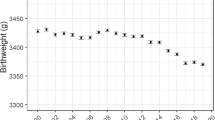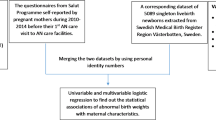Abstract
During the last decade there have been significant socio-demographic changes in Spain with potential impact on gestational length. The aim of the study was to describe the evolution of gestational age during 1997–2008, separately for native-born and immigrant population, in order to assess their contribution to the overall pattern of gestational length. A cross-sectional study of 5,018,229 singleton births born between 1997 and 2008 was carried out. The annual mean of gestational age was calculated and compared by means of ANOVA test, globally and also separately for natives and immigrants. Proportions of deliveries by gestational age and maternal characteristics were calculated in 4 periods and compared by means of Chi-square tests. Crude and adjusted multinomial logistic regression models were fitted separately for native-born and immigrant women. Our results show that in the last 12 years a progressive shortening in the mean gestational age has taken place in Spain. While the overall decrease of gestational length along the period was 1.5 days, closer to that in Spanish women (1.3 days), it was 2.3 days among immigrants. In both groups this shortening was mainly due to an increase in the proportion of 37–39 weeks deliveries at the expense of a substantial decrease in those with 40 weeks. These trends remained after controlling for known confounding variables such as maternal age, parity and occupation. Further analysis of its causes and public health implications are recommended.


Similar content being viewed by others
References
Bergsjø P, Denman DW 3rd, Hoffman HJ, Meirik O. Duration of human singleton pregnancy. A population-based study. Acta Obstet Gynecol Scand. 1990;69(3):197–207.
Delpisheh A, Brabin L, Attia E, Brabin BJ. Pregnancy late in life: a hospital-based study of birth outcomes. J Womens Health (Larchmt). 2008;17(6):965–70.
St-Laurent J, De Wals P, Moutquin JM, Niyonsenga T, Noiseux M, Czernis L. Biopsychosocial determinants of pregnancy length and fetal growth. Paediatr Perinat Epidemiol. 2008;22(3):240–8.
Petridou E, Trichopoulos D, Tong D, Revinthi K, Tsitsika A, Papathoma E, Aravantinos D. Modulators of length of gestation. A study in Greece. Eur J Public Health. 1996;6:159–65.
Hosseini SM, Biglan MW, Larkby C, Brooks MM, Gorin MB, Day NL. Trait anxiety in pregnant women predicts offspring birth outcomes. Paediatr Perinat Epidemiol. 2009;23(6):557–66.
Tegethoff M, Greene N, Olsen J, Meyer AH, Meinlschmidt G. Maternal psychosocial adversity during pregnancy is associated with length of gestation and offspring size at birth: evidence from a population-based cohort study. Psychosom Med. 2010;72(4):419–26.
Mamelle N, Laumon B, Lazar P. Prematurity and occupational activity during pregnancy. Am J Epidemiol. 1984;119:309–22.
Saurel-Cubizolles MJ, Zeitlin J, Lelong N, Papiernik E, Di Renzo GC, Bréart G. Europop group. Employment, working conditions, and preterm birth: results from the Europop case-control survey. J Epidemiol Community Health. 2004;58(5):395–401.
Guendelman S, Pearl M, Graham S, Hubbard A, Hosang N, Kharrazi M. Maternity leave in the ninth month of pregnancy and birth outcomes among working women. Womens Health Issues. 2009;19(1):30–7.
Stillerman KP, Mattison DR, Giudice LC, Woodruff TJ. Environmental exposures and adverse pregnancy outcomes: a review of the science. Reprod Sci. 2008;15(7):631–50. Review.
Allen VM, Wilson RD, Cheung A, Genetics Committee of the Society of Obstetricians and Gynaecologists of Canada (SOGC); Reproductive Endocrinology Infertility Committee of the Society of Obstetricians and Gynaecologists of Canada (SOGC). Pregnancy outcomes after assisted reproductive technology. J Obstet Gynaecol Can. 2006;28(3):220–50.
Welmerink DB, Voigt LF, Daling JR, Mueller BA. Infertility treatment use in relation to selected adverse birth outcomes. Fertil Steril. doi:10.1016/j.fertnstert.2010.03.005.
Oshiro BT, Henry E, Wilson J, Branch DW, Varner MW, Women and Newborn Clinical Integration Program. Decreasing elective deliveries before 39 weeks of gestation in an integrated health care system. Obstet Gynecol. 2009;113(4):804–11.
Roberts CL, Taylor L, Henderson-Smart D. Trends in births at and beyond term: evidence of a change? Br J Obstet Gynaecol. 1999;106(9):937–42.
Davidoff MJ, Dias T, Damus K, Russell R, Bettegowda VR, Dolan S, Schwarz RH, Green NS, Petrini J. Changes in the gestational age distribution among U.S. singleton births: impact on rates of late preterm birth, 1992 to 2002. Semin Perinatol. 2006;30(1):8–15.
Astolfi P, De Pasquale A, Zonta LA. Gestational age shortening in single births at term. Italy 1990–1998. Eur J Epidemiol. 2007;22(4):263–5.
Donahue SM, Kleinman KP, Gillman MW, Oken E. Trends in birth weight and gestational length among singleton term births in the United States: 1990–2005. Obstet Gynecol. 2010;115(2 Pt. 1):357–64.
Bosch X. Investigating the reasons for Spain’s falling birth rate. Lancet. 1998;352(9131):887.
Matorras R, Expósito A, Carreras M. Fertility policy in Spain. Pharmaceuticals Policy and Law.2007;9:229–33. http://iospress.metapress.com/content/1ll3dg5j7vx45vny/fulltext.pdf Accessed 02 July 2010.
Spanish National Statistics Register. Population in 2009 by country of birth. http://www.ine.es/jaxi/tabla.do?path=/t20/e245/p04/provi/l0/&file=00000011.PX&type=pcaxis&L=0 Accessed 01 July 2010.
Spanish National Statistics Register. Births by mother’s nationality in 2009. http://www.ine.es/jaxi/tabla.do?path=/t20/e301/nacim/a2008/l0/&file=05005.px&type=pcaxis&L=0 Accessed 01 July 2010.
Papiemik E, Alexander GR, Paneth N. Racial differences in pregnancy duration and its implications for perinatal care. Med Hypotheses. 1990;33:181–6.
Wilcox M, Gardosi J, Mongelli M, Ray C, Johnson I. Birthweight from pregnancies dated by ultrasonography in a multicultural British population. BMJ. 1993;307:588–91.
Patel RR, Steer P, Doyle P, Little MP, Elliott P. Does gestation vary by ethnic group? A London-based study of over 122, 000 pregnancies with spontaneous onset of labour. Int J Epidemiol. 2004;33(1):107–13.
Nielsen J, ed. Births and infant mortality in the Nordic countries.Copenhagen: Nordic Medico-Statistical Committee (NOMESCO), 1993:39.
Stoltenberg C, Magnus P. Children with low birth weight and low gestational age in Oslo, Norway: immigration is not the cause of increasing proportions. J Epidemiol Community Health. 1995;49(6):588–93.
Malin M, Gissler M. Maternal care and birth outcomes among ethnic minority women in Finland. BMC Public Health. 2009;9:84.
Manzanares Galan S, López Gallego MF, et al. Results of poor prenatal care in the immigrant population. Progresos de Obstetricia y Ginecología. 2008;51(4):9.
Puig Sola C, Zarzoso Palomero A, et al. [Hospital admission in newborns according to ethnicity and parents’ country of origin in an urban area of Barcelona [Spain]]. Gac Sanit. 2008;22(6):555–64.
Tierney-Gumaer R, Reifsnider E. Risk factors for low birth weight infants of Hispanic, African American, and White women in Bexar County, Texas. Public Health Nurs. 2008;25(5):390–400.
Yang H, Kramer MS, Platt RW, Blondel B, Bréart G, Morin I, Wilkins R, Usher R. How does early ultrasound scan estimation of gestational age lead to higher rates of preterm birth? Am J Obstet Gynecol. 2002;186(3):433–7.
Ananth CV. Menstrual versus clinical estimate of gestational age dating in the United States: temporal trends and variability in indices of perinatal outcomes. Paediatr Perinat Epidemiol. 2007;21(Suppl 2):22–30.
Indicadores de actividad hospitalaria en España. (2000–2005). http://www.msc.es/estadEstudios/estadisticas/docs/serie_escri_00_05_es.pdf Accessed 30 July 2010.
Guendelman S, Buekens P, Blondel B, Kaminski M, Notzon FC, Masuy-Stroobant G. Birth outcomes of immigrant women in the United States, France, and Belgium. Matern Child Health J. 1999;3(4):177–87.
Vahratian A, Buekens P, Delvaux T, Boutsen M, Wang Y, Kupper LL. Birthweight differences among infants of North African immigrants and Belgians in Belgium. Eur J Public Health. 2004;14(4):381–3.
Buekens P, Masuy-Stroobant G, Delvaux T. High birthweights among infants of north African immigrants in Belgium. Am J Public Health. 1998;88(5):808–11.
Callister LC, Birkhead A. Acculturation and perinatal outcomes in Mexican immigrant childbearing women: an integrative review. J Perinat Neonatal Nurs. 2002;16(3):22–38. Review.
Page RL. Positive pregnancy outcomes in Mexican immigrants: what can we learn? J Obstet Gynecol Neonatal Nurs. 2004;33(6):783–90. Review.
Urquia ML, Frank JW, Moineddin R, Glazier RH. Immigrants’ duration of residence and adverse birth outcomes: a population-based study. BJOG. 2010;117(5):591–601.
Río I, Castelló A, Jané M, Prats R, Barona C, Más R, Rebagliato M, Zurriaga O, Bolúmar F. Reproductive and perinatal health indicators in immigrant and Spanish-born women in Catalonia and Valencia (2005–2006). Gac Sanit. 2010;24(2):123–7.
Acknowledgments
Spanish Ministry of Science and Innovation (SEJ 2005/07679); CIBER of Epidemiology and Public Health (Ciberesp, Spain).
Author information
Authors and Affiliations
Corresponding author
Rights and permissions
About this article
Cite this article
Castelló, A., Río, I., Sandín-Vázquez, M. et al. Shortening of gestational length among native-born and immigrants in Spain (1997–2008). Eur J Epidemiol 26, 563–570 (2011). https://doi.org/10.1007/s10654-011-9591-4
Received:
Accepted:
Published:
Issue Date:
DOI: https://doi.org/10.1007/s10654-011-9591-4




